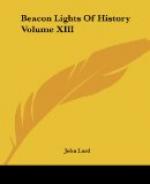But there is another and higher sense of the word dramatic, where Goethe is supreme,—the sense in which Dante’s great poem is called Commedia, a play. There is a drama whose scope is beyond the compass of any earthly stage,—a drama not for theatre-goers, to be seen on the boards, but for intellectual contemplation of men and angels. Such a drama is “Faust,” of which I shall speak hereafter.
Of Goethe’s prose works,—I mean works of prose fiction,—the most considerable are two philosophical novels, “Wilhelm Meister” and the “Elective Affinities.”
In the first of these the various and complex motives which have shaped the composition may be comprehended in the one word education,—the education of life for the business of life. The main thread of the narrative traces through a labyrinth of loosely connected scenes and events the growth of the hero’s character,—a progressive training by various influences, passional, intellectual, social, moral, and religious. These are represented by the personnel of the story. In accordance with this design, the hero himself, if so he may be called, has no pronounced traits, is more negative than positive, but is brought into contact with many very positive characters. His life is the stage on which these characters perform. A ground is thus provided for the numerous portraits of which the author’s large experience furnished the originals, and for lessons of practical wisdom derived from his close observation of men and things and his lifelong reflection thereon.
“Wilhelm Meister,” if not the most artistic, is the most instructive, and in that view, next to “Faust,” the most important, of Goethe’s works. In it he has embodied his philosophy of life,—a philosophy far enough removed from the epicurean views which ignorance has ascribed to him,—a philosophy which is best described by the term ascetic. Its keynote is Renunciation. “With renunciation begins the true life,” was the author’s favorite maxim; and the second part of “Wilhelm Meister”—the Wanderjahre—bears the collateral title Die Entsagenden; that is, the “Renouncing” or the “Self-denying.” The characters that figure in this second part—most of whom have had their training in the first—form a society whose principle of union is self-renunciation and a life of beneficent activity....
The most fascinating character in “Wilhelm Meister”—the wonder and delight of the reader—is Mignon, the child-woman,—a pure creation of Goethe’s genius, without a prototype in literature. Readers of Scott will remember Fenella, the elfish maiden in “Peveril of the Peak.” Scott says in his Preface to that novel: “The character of Fenella, which from its peculiarity made a favorable impression on the public, was far from being original. The fine sketch of Mignon in Wilhelm Meister’s Lehrjahre—a celebrated work from the pen of Goethe—gave the idea of such a being. But the copy will be found to be greatly different from my great prototype; nor can I be accused of borrowing anything save the general idea.”




